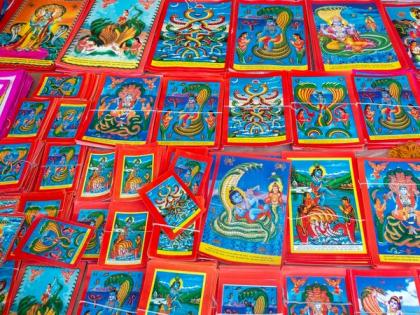Nepal observes "Naag Panchami" worshipping serpent deity
By ANI | Updated: July 29, 2025 10:14 IST2025-07-29T10:07:16+5:302025-07-29T10:14:36+5:30
Kathamandu [Nepal], July 29 : Dozens of devotees thronged to the Naag Pokhari, the serpent pond in the capital, ...

Nepal observes "Naag Panchami" worshipping serpent deity
Kathamandu [Nepal], July 29 : Dozens of devotees thronged to the Naag Pokhari, the serpent pond in the capital, worshipping the serpent deity while observing the festivity of Naag Panchami.
The fifth day of the bright half-moon of the Shrawan month, as per the lunar calendar, is regarded as Naag Panchami, a day dedicated to serpent deities. People flock to nearby ponds and Naag temples to worship the serpentine deity. With this, the festive season starts in the Himalayan nation.
Devotees who thronged the famous Naag Pokhari to worship the serpent deity on Naag Panchami offered vermilion powder, flowers, and milk as they felt relieved to worship the serpent on its day.
"Naag Pooja, as per our Hindu belief and tradition, the Shesh Naag balances the earth on his head. Today, we have the tradition of worshipping all the serpent deities Shesh Naag. We all have distinct procedures to perform the rituals of Naag Pooja. Though all of the required items are not available, we carried out the ritual with those that were.
During the ritual of worshipping the serpent deity, we basically use barley, sesame seeds, incense sticks, flowers and leaves, the drawing of Naag as well as those made using cotton. The serpent deity worshipped during the monsoon is believed to veer off evil spirits and protect from disasters caused by serpents, as they protect those who worship them," Chhabilal Tiwari, a devotee who thronged the sacred pond, told ANI.
The Naag Pokhari, a pond dedicated to the serpent deity in Naxal of Kathmandu, was worshipped and made special offerings of dubo grass, flowers, and rice grains mixed with red vermillion powder. Along with milk, fruits and sweets made of milk are also offered, with the lighting of incense sticks and lamps in homage to the serpent deities.
The festival of Naag Panchami is also regarded as a festival to strengthen the bond between humans and nature. On this particular day, farmers don't dig or plough the fields; rather, they worship the deity by making idols from the mud of their fields.
The serpentine deity is also regarded as the god of water and rain. As per religious belief, it is said that the house where the Naag deity resides is bestowed with wealth and prosperity.
According to legend, the age-old tradition of observing the festival started when a farmer in ancient times had ploughed his field on the day of Naag Panchami and killed a family of serpents. The serpent then vowed not to spare any member of the farmer's family. After the entire family was killed, only the farmer's daughter who had been married off was left. When the serpent went to her house to take revenge, it saw the daughter worshipping the serpent deity. The snake, who had lost its family, returned after blessing the girl.
The festival of Naag Panchami is also regarded as a festival to strengthen the bond between humans and nature. On this particular day, farmers don't dig or plough the fields; rather, they worship the deity by making idols from the mud of their fields.
The serpentine deity is also regarded as the god of water and rain. As per religious belief, it is said that the house where the Naag deity resides is bestowed with wealth and prosperity.
Disclaimer: This post has been auto-published from an agency feed without any modifications to the text and has not been reviewed by an editor
Open in app